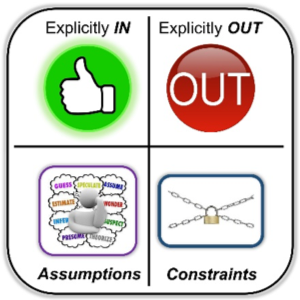 This article focuses on one of the most fundamental principles of project management that is critical for any Project Manager, leader, or organization to understand. That topic is “Scope”. As I proposed this topic, one of my LinkedIn cyber colleagues (Bill Duncan) added that he teaches scope in two parts – the Product Scope (which is what you will be delivering at the end of the project) and the Work Scope (which is how you will organize the work and deliver the effort within the confines of the project).
This article focuses on one of the most fundamental principles of project management that is critical for any Project Manager, leader, or organization to understand. That topic is “Scope”. As I proposed this topic, one of my LinkedIn cyber colleagues (Bill Duncan) added that he teaches scope in two parts – the Product Scope (which is what you will be delivering at the end of the project) and the Work Scope (which is how you will organize the work and deliver the effort within the confines of the project).
Additionally, another one of my groups (facilitated by Andrew Kallman) brought up the topic of Scope and posted a link to the excellent video presentation by Mary Poppendieck titled “The Tyranny of ‘The Plan’”. Her presentation focused on the project to build the Empire State Building and how that massive scope was managed and leveraged to one of the most successful conclusions in modern architecture history. The link to that presentation is included later in the article. I highly recommend investing the hour it takes to watch the it.
 As I’ve taught project management over the course of several decades, I’ve focused in on a few principles that I consider “key” to a basic understanding. When it comes to teaching and discussing Scope, I refer to the “Four Pillars” that comprise it and should be clearly understood in order to give any organization or team the best chance for a successful outcome. Those four pillars are: 1) what is explicitly IN Scope, 2) what is explicitly OUT of Scope, 3) what Assumptions are made at the beginning of the project about Scope, and 4) what Constraints applicable to Scope will we need to manage. This article will cover all four, but then we’ll focus on Constraints and how a successful project will manage within and to them, as opposed to fighting them and trying to find a way to get around them during the project.
As I’ve taught project management over the course of several decades, I’ve focused in on a few principles that I consider “key” to a basic understanding. When it comes to teaching and discussing Scope, I refer to the “Four Pillars” that comprise it and should be clearly understood in order to give any organization or team the best chance for a successful outcome. Those four pillars are: 1) what is explicitly IN Scope, 2) what is explicitly OUT of Scope, 3) what Assumptions are made at the beginning of the project about Scope, and 4) what Constraints applicable to Scope will we need to manage. This article will cover all four, but then we’ll focus on Constraints and how a successful project will manage within and to them, as opposed to fighting them and trying to find a way to get around them during the project.
Whether you are considering Scope in terms of the work, the product, or both (probably the better approach), the first element to consider is the concept of what is Explicitly IN scope. This can be a fairly discrete list of features and functions. It should absolutely be a clear reflection of the Value you intend to deliver as connected to the overarching Vision the organization’s leadership has cast. Having this “pillar” in place can help inhibit the natural tendency toward scope creep or gold plating (yes, they are two different things). It gives you a basis against which to compare pretty much anything and helps you set the fences for what is explicitly In.
Explicitly Out of Scope
 Conversely, you may find there are elements that need to be categorized as Explicitly OUT of scope. Taking a cue from the “In” universe, this group accounts for features and functions some on your project may assume are included but actually are not. Again, aligning with Value as driven by Vision, this helps to reinforce the boundaries you are setting in terms of the overall scope (both work and product). Clear definition here can help set expectations, drive out productive discussions, and distill agreement about your project and the entire Vision to Value chain.
Conversely, you may find there are elements that need to be categorized as Explicitly OUT of scope. Taking a cue from the “In” universe, this group accounts for features and functions some on your project may assume are included but actually are not. Again, aligning with Value as driven by Vision, this helps to reinforce the boundaries you are setting in terms of the overall scope (both work and product). Clear definition here can help set expectations, drive out productive discussions, and distill agreement about your project and the entire Vision to Value chain.
Assumptions
 The third “pillar” to consider is often overlooked by project managers and teams. They may perform some due diligence up front, but then these items are forgotten until they rear up and cause problems, confusion, delays, and general mayhem. I’m talking about Assumptions (though we often treat project risks the same way). By the most basic definition, assumptions are statements we consider to be true as originally documented until something (or someone) proves that to be incorrect. The problems come when no one challenges or revisits assumptions during the course of the project and, as a consequence, the results suffer or need to be altered based on the reality we are facing.
The third “pillar” to consider is often overlooked by project managers and teams. They may perform some due diligence up front, but then these items are forgotten until they rear up and cause problems, confusion, delays, and general mayhem. I’m talking about Assumptions (though we often treat project risks the same way). By the most basic definition, assumptions are statements we consider to be true as originally documented until something (or someone) proves that to be incorrect. The problems come when no one challenges or revisits assumptions during the course of the project and, as a consequence, the results suffer or need to be altered based on the reality we are facing.
Constraints
 The final Scope “pillar” (and the one that prompted this article in the first place) is Constraints. As shown in the illustration, you will find constraints exerting force on your project from the “four corners of the Earth” in many cases. A popular way to deal with constraints in the context of a project is to attempt to minimize or eliminate them. They are holding us back, after all. So, by moving beyond the constraints we face, we’ll end up with a smoother, more productive project and get to the end in better shape … right?
The final Scope “pillar” (and the one that prompted this article in the first place) is Constraints. As shown in the illustration, you will find constraints exerting force on your project from the “four corners of the Earth” in many cases. A popular way to deal with constraints in the context of a project is to attempt to minimize or eliminate them. They are holding us back, after all. So, by moving beyond the constraints we face, we’ll end up with a smoother, more productive project and get to the end in better shape … right?
Well, maybe not. As an example, take a look at the massive project to design and build the Empire State Building (the subject of Mary Poppendieck’s talk). The actual build started on March 17, 1930. Obviously design and planning preceded that date, but when you consider it was completed and ready for occupancy just thirteen months later (April 11, 1931 which was just in time for the annual office leases in New York City to renew on May 1), it is truly a marvel of modern engineering. And, rather than expending effort to remove or circumvent constraints, the team chose to leverage them to their advantage.
A Modern Engineering Marvel for its Time
 As an example, and due to the constraint of the physical space around the construction site, only about two weeks’ worth of materials were ever on hand at a time. The builders leveraged alternating suppliers for key components such as steel and concrete and had them delivered according to a schedule that fell within the timing and space constraints. The architects and sponsors wanted elevators that went all the way to the top without occupants or visitors having to switch cars at various floors. This constraint resulted in a design that ensured the elevator shafts were designed and built to meet this goal and coordinated with the floor-by-floor construction work.
As an example, and due to the constraint of the physical space around the construction site, only about two weeks’ worth of materials were ever on hand at a time. The builders leveraged alternating suppliers for key components such as steel and concrete and had them delivered according to a schedule that fell within the timing and space constraints. The architects and sponsors wanted elevators that went all the way to the top without occupants or visitors having to switch cars at various floors. This constraint resulted in a design that ensured the elevator shafts were designed and built to meet this goal and coordinated with the floor-by-floor construction work.
Due to New York City weather, the superstructure and exterior building skin were completed first, so the entire building was enclosed before the winter weather of 1930/1931 set in. Accommodating that constraint allowed the builders to pivot work to the interior floors and spurred them on to the rapid completion and subsequent occupancy. While the building didn’t actually make money for the investors for almost another two decades (largely due to the Great Depression), the stage was set for the future of what reigned as the world’s tallest building and, as President Hoover pressed a button to “turn on the lights”, history was made and the world never looked back.
In retrospect, by respecting all four Scope pillars outlined above and, especially, working within the constraints as presented, the Value (as set by the Vision) was achieved in record time and in a way that hasn’t been duplicated (at least not on the same scale). By choosing to scope to the constraints, the Empire State Building project stands as a shining example of what is possible to accomplish.
To see Mary Poppendieck’s full presentation, view her “Tyranny of ‘The Plan’” talk at the following link: https://www.infoq.com/presentations/tyranny-of-plan/
Bio
Mark Moore, M2PCC’s Executive Consultant, is an experienced leader and communicator, with a long track record of successful program and project management, training development and delivery, and transformational change. He brings over three decades of experience spanning multiple industries and disciplines. His focus on delivery of Value aligned with Vision lies at the heart of FLOW and organizational transformation.
Executive Consultant
mark@m2projectconsultingcorp.com
919.724.3679

